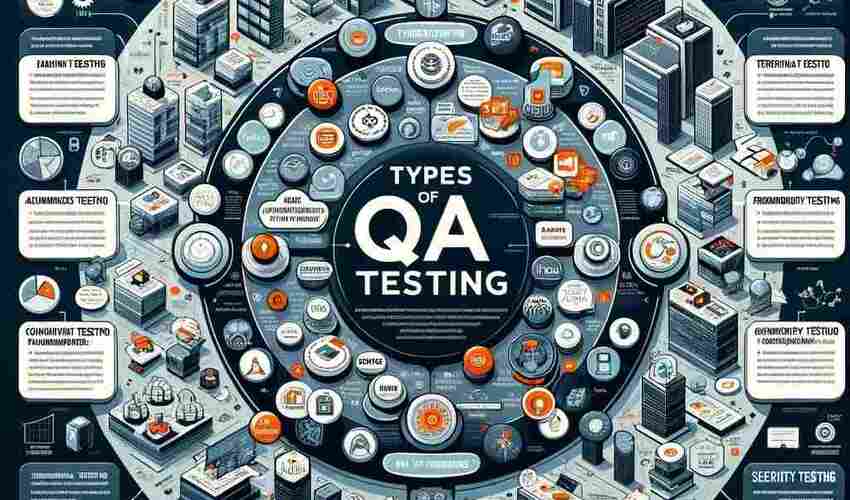Exploring the Different Types of QA Testing: A Comprehensive Guide

Quality Assurance (QA) testing is a crucial component in the software development life cycle. It ensures that the software meets the desired quality standards before it is released to the public. Understanding the different types of QA testing can help teams select the right tests at different stages of development to enhance the product’s quality, functionality, and user experience. This comprehensive guide will explore the different types of QA testing, helping developers and testers make informed decisions throughout the development process.
Here is a list of Different types of QA Testing in 2024.
- Functional Testing
- Manual Testing
- Automation Testing
- Performance Testing
- Compatibility Testing
- Visual Testing
- Regression Testing
- Unit Testing
- Integration Testing
- End-to-end Testing
- AI Testing
1. Functional Testing
Functional testing is a type of QA testing that is concerned with testing the software system against the functional requirements specified by the client or derived from the design documents. This process involves providing input to the system and verifying the output to ensure that the actual results match the expected results. The primary objective of functional testing is to check the usability, accessibility, and reliability of the functional parts of the application before it goes live.
Functional testing does not involve the application’s internal workings; instead, it focuses on user expectations and the result of the operations performed. This ensures the software adheres to the requirements and performs its intended functions correctly in all scenarios.
Subtypes of Functional Testing
Functional testing encompasses several subtypes, each targeting specific aspects of the software’s functionality:
- Unit Testing
- Definition: Unit testing involves testing individual components or units of a software application. It is usually performed by the developers themselves using the white box testing method.
- Purpose: The goal is to validate that each software unit performs as designed. This testing level is the first line of defense, helping to catch bugs at an early stage.
- Integration Testing
- Definition: Integration testing focuses on combining and testing units as a group to evaluate the interaction between integrated units.
- Purpose: This testing ensures your application’s modules or services work well together. It can be performed in a top-down, bottom-up, or sandwich approach.
- System Testing
- Definition: System testing is a level where the complete and integrated software is tested. The purpose is to evaluate the end-to-end system specifications.
- Purpose: It is often performed in an environment closely resembling the production environment where the application will be released. System testing ensures that the software, data, and integration function as expected.
- Sanity Testing
- Definition: Sanity testing is a subset of regression testing. It focuses on testing specific functionalities after making slight changes to the software. It is a quick, non-exhaustive testing mode focusing on one or a few areas of functionality.
- Purpose: Generally, sanity testing ensures the proposed functionality works roughly as expected. It helps to reject a software build early in the testing cycle if failed.
- Smoke Testing
- Definition: Smoke testing consists of minimal attempts to operate the software to determine whether any fundamental problems will prevent it from working.
- Purpose: This test is carried out before detailed functional or regression tests are executed on a new software build.
- Regression Testing
- Definition: Regression testing involves re-running functional and non-functional tests to ensure that previously developed and tested software performs after a change.
- Purpose: Whenever modifications are made to the code, defects can be introduced into existing functional and non-functional areas of the software. Regression testing addresses this risk.
- User Acceptance Testing (UAT)
- Definition: UAT is the final phase of the software testing process. During UAT, actual software users test the software to ensure it can handle required tasks in real-world scenarios according to specifications.
- Purpose: UAT is important because it ensures the software can handle required tasks in real-world scenarios according to the specifications.
2. Manual Testing
Manual testing is the process of manually checking software for defects. It requires a tester to play the role of an end user, who uses most of the application’s features to ensure correct behaviour. This testing method is considered foundational in the software development lifecycle and is crucial for validating the usability and functionality of software systems. Unlike automated testing, manual testing does not require any software tools. Testers perform tests on the software by following a set of predefined test cases.
Subtypes of Manual Testing
Manual testing can be categorized into several subtypes, each focusing on specific testing requirements and objectives:
- Exploratory Testing
- Definition: Exploratory testing is a hands-on approach in which testers explore the software to identify defects without predefined test cases. This type of QA testing relies on the tester’s skill, intuition, and experience with the software.
- Purpose: The main goal of exploratory testing is quickly finding as many defects as possible. It allows testers to think outside the box and find critical bugs that scripted testing might miss.
- Ad-hoc Testing
- Definition: Ad-hoc testing is similar to exploratory testing in that it is informal and not scripted. However, it is typically done after formal testing has occurred to perform random checks where formal test cases do not cover.
- Purpose: The purpose of ad-hoc testing is to catch potential defects that were not found during the structured testing processes. It relies heavily on the tester’s insights and knowledge of the system.
- Usability Testing
- Definition: Usability testing involves evaluating a product by testing it with real users. It focuses on the user’s ease of using the application, flexibility in handling controls, and the ability of the system to meet its objectives.
- Purpose: The primary aim is to identify any usability issues with the software so that the end product is as user-friendly and efficient as possible.
- Accessibility Testing
- Definition: Accessibility testing checks the software’s usability by people with disabilities (physical, cognitive, and sensory). It ensures compliance with various laws and standards, such as the Americans with Disabilities Act (ADA) and Web Content Accessibility Guidelines (WCAG).
- Purpose: To ensure that people with a wide range of physical and cognitive abilities can successfully use the software.
- Compatibility Testing
- Definition: Compatibility testing examines whether the software can run on different hardware, operating systems, applications, network environments, or mobile devices.
- Purpose: This ensures the software application behaves as expected across various environments, providing a broader user base.
- User Acceptance Testing (UAT)
- Definition: User Acceptance Testing, as a manual testing process, involves the clients/end-users testing the software to verify if it can handle required tasks in real-world scenarios according to their specifications.
- Purpose: UAT is critical as it ensures that the software is capable and ready for release to the market. It confirms that the software meets all business requirements and is bug-free.
3. Automation Testing
Automation testing involves using specialized software tools to execute predefined tests on the software application automatically and then comparing the actual outcomes with the expected results. This form of testing is essential for continuous integration and delivery pipelines in modern software development practices. It helps teams to execute repetitive tasks quickly and efficiently, which enhances the scope, accuracy, and speed of tests.
Subtypes of Automation Testing
Automation testing can be broadly categorized into several types, each focusing on specific testing needs and outcomes:
- Unit Testing
- Definition: Unit testing tests an application’s most minor testable parts, like functions or methods. Automation in unit testing is typically done by developers using frameworks such as JUnit, NUnit, or TestNG.
- Purpose: Automated unit testing ensures that changes to the code have not adversely affected existing functionalities. It’s crucial for maintaining code health over time and for supporting refactoring and integration.
- Integration Testing
- Definition: Automation integration testing involves testing the interfaces between components or systems. Tools like Postman for API testing or Selenium for UI integration testing can be used.
- Purpose: This ensures that the components or systems work together as expected. Automated integration testing is precious in microservices architectures where multiple services must interact seamlessly.
- Functional Testing
- Definition: Automated functional testing tests specific scenarios in the software against the functional requirements. This can be achieved through Selenium, QTP, or Telerik Test Studio.
- Purpose: To verify that an application’s visible and interactive aspects function as expected, ensuring the application behaves as users would expect.
- Regression Testing
- Definition: Automated regression testing involves re-running functional and non-functional tests to ensure that previously developed and tested software performs after a change.
- Purpose: Automation makes regression testing more efficient, as tests can be run automatically after every change, ensuring that new code does not disrupt existing functionality.
- Performance Testing
- Definition: Performance testing is automated to test various aspects of system performance under load. Tools such as JMeter, LoadRunner, or Gatling are used to simulate multiple users or high loads on applications.
- Purpose: To ensure the application performs well under expected and peak load conditions. This includes testing for speed, scalability, and reliability.
- GUI Testing
- Definition: GUI testing involves testing the application’s graphical user interface to ensure it meets specified design guidelines. Tools like Selenium, QTP, and Ranorex automate these processes to ensure all visual elements function correctly across various devices and resolutions.
- Purpose: Automated GUI testing helps identify visual issues and ensure that the application is responsive and visually consistent across multiple platforms.
- Security Testing
- Definition: Automated security testing includes using tools to identify and mitigate security vulnerabilities within the software. Tools like OWASP ZAP, Burp Suite, or Fortify are used to automate security scans.
- Purpose: To ensure the application is secure against attacks, protecting data integrity and user privacy.
- API Testing
- Definition: API testing automates testing of the application programming interfaces (APIs) at the message layer. Tools like Postman, RestAssured, and SoapUI are popular for automating API testing.
- Purpose: To ensure that APIs meet reliability, performance, and security expectations. Automated API testing is essential for back-end testing where the UI may not be involved.
4. Performance Testing
Performance testing is a critical type of testing that focuses on determining the speed, responsiveness, and stability of a computer, network, software program, or device under a workload. It is crucial to ensure that a software application will perform well under its expected real-life load. Unlike functional testing, which ensures that functions are performed correctly, performance testing validates non-functional parameters such as responsiveness and stability.
Subtypes of Performance Testing
Performance testing can be divided into several subtypes, each designed to measure different aspects of system performance:
- Load Testing
- Definition: Load testing involves simulating a specific expected number of concurrent users accessing the application to check how the system behaves under normal and peak load conditions.
- Purpose: The primary purpose of load testing is to identify performance bottlenecks before the software application becomes available to the public. It helps ensure the application can handle the anticipated traffic volume without degradation in performance.
- Stress Testing
- Definition: Stress testing is designed to overload the system with extreme loads, often beyond the levels it can handle, to see how it responds and recovers when returning to normal usage.
- Purpose: This testing helps identify the upper limits of capacity within the system. It also ensures that the system fails and recovers gracefully, a concept known as failover testing.
- Spike Testing
- Definition: Spike testing is a subtype of stress testing where the software is subjected to extreme spikes in the load at very sudden intervals.
- Purpose: The goal is to determine whether the system can sustain dramatic changes in user load. It is helpful in understanding how the system behaves during sudden increases in user activity.
- Volume Testing
- Definition: Volume testing, or flood testing, involves a massive volume of data being processed to analyze system performance and behavior under varying database volumes.
- Purpose: This test ensures the application can handle large amounts of data without any issues or performance degradation.
- Scalability Testing
- Definition: Scalability testing tests a system’s effectiveness in “scaling up” to support increased user load. It helps to understand when the system’s performance starts to degrade or fail.
- Purpose: To determine if the current architecture will support future growth. If it doesn’t, recommendations are made to improve scaling capabilities.
- Soak Testing
- Definition: Soak testing involves running a system at high load levels to identify performance issues that might arise during sustained use.
- Purpose: This helps identify problems like memory leaks, slowdowns stemming from prolonged system operation, or failures caused by certain conditions only detectable after the system has been under stress for a while.
- Endurance Testing
- Definition: Similar to soak testing, endurance testing involves testing a system with a typical workload over a long period to identify how it behaves under sustained use.
- Purpose: Endurance testing aims to ensure that the system can handle the expected load over a long duration without any deterioration of response times or other stability issues.
- Concurrency Testing
- Definition: Concurrency testing checks the system’s performance by simulating multiple users performing the same operations simultaneously.
- Purpose: To identify issues that only appear when multiple users use the system concurrently, such as deadlocks in database access.
5. Compatibility Testing
Compatibility testing is a type of non-functional testing that ensures a software application performs well across various environments, hardware, software, network configurations, and other system dependencies. It’s crucial in today’s diverse tech ecosystem, where users access applications on different devices, operating systems, and browsers. Compatibility testing helps to identify how well the application behaves and appears under different combinations of environmental conditions, ensuring a uniform experience for all users.
Subtypes of Compatibility Testing
Compatibility testing can be divided into various subtypes, each focusing on different aspects of the system compatibility:
- Browser Compatibility Testing
- Definition: This testing checks whether the web application works as expected across browsers like Google Chrome, Mozilla Firefox, Internet Explorer, Safari, etc.
- Purpose: To ensure that web applications offer a consistent user experience, regardless of the browser used. This includes checking layout, functionality, and performance on different browsers.
- Operating System Compatibility Testing
- Definition: Tests the software application’s compatibility with different operating systems, such as Windows, Mac OS, Linux, Android, iOS, etc.
- Purpose: To verify that the application performs consistently across all operating systems for which it is intended. This involves checking software behavior over various system updates and versions.
- Mobile Device Compatibility Testing
- Definition: Ensures that the application functions correctly across various mobile devices with differing screen sizes, resolutions, hardware specifications, and operating systems.
- Purpose: Given the plethora of mobile devices available in the market, this testing helps ensure that the app offers a uniform user experience across all devices, catering to touchscreen responsiveness and mobile usability.
- Hardware Compatibility Testing
- Definition: Tests the software’s compatibility with hardware configurations such as processors, memory, graphics cards, and storage devices.
- Purpose: To ensure the software can operate with different hardware specifications without degrading performance, functionality, or data integrity.
- Network Compatibility Testing
- Definition: Evaluate the performance and behavior of a networked application under various network parameters such as bandwidth, operating speed, and capacity.
- Purpose: To check how network differences affect the performance or behavior of applications, particularly for those heavily dependent on network connectivity.
- Software Compatibility Testing
- Definition: Tests whether the application can operate with other software applications, including third-party plugins, databases, or other external dependencies.
- Purpose: To ensure that the software integrates and operates efficiently with other software systems, which is crucial for applications that rely on external APIs or run in complex software environments.
- Version Compatibility Testing
- Definition: Tests the application’s compatibility with different versions of software, including older and newer versions of software it interacts with.
- Purpose: To ensure that updates or versions of the application or its related software do not disrupt the user experience. It is crucial for software that relies on continuous updates or backward compatibility.
6. Visual Testing
Visual testing is a type of QA testing that focuses primarily on the graphical user interface (GUI) and the visual aspects of an application to ensure that the UI appears correctly to the users. It involves examining the application’s screens with the naked eye or using automated tools to spot layout errors, alignment issues, color mismatches, and other visual inconsistencies that could affect user experience. Visual testing is crucial for applications where the visual representation directly impacts user satisfaction and usability.
Subtypes of Visual Testing
Visual testing can be categorized into several subtypes, each targeting specific visual aspects of the application:
- UI Responsiveness Testing
- Definition: This subtype of visual testing focuses on how the application’s UI renders across different devices with varying screen sizes, resolutions, and orientations.
- Purpose: The aim is to ensure the application is responsive and provides an optimal user experience on all devices, from desktops to smartphones. This includes checking layouts, images, buttons, text boxes, and other UI elements for adaptability and visual appeal.
- Cross-Browser Visual Testing
- Definition: Tests how the application’s visual elements appear and function across web browsers.
- Purpose: To ensure that the application provides a consistent visual experience regardless of the user’s browser. This involves verifying font sizes, colors, layouts, and interactive elements like buttons and links.
- Color Testing
- Definition: Focuses on the correct implementation of color schemes and the visibility of text and graphics across various backgrounds.
- Purpose: This testing ensures that colors used in the application meet design specifications and are consistent across the app. It is also important for accessibility, ensuring that color combinations are perceivable by all users, including those with color vision deficiencies.
- Font Testing
- Definition: Verifies that the application uses the correct fonts, sizes, and styles as per the design specifications.
- Purpose: To ensure readability and consistency of text throughout the application. This includes checking for text overlaps cut-offs and ensuring that the text is legible across different devices and resolutions.
- Image Testing
- Definition: Ensures that all images in the application load correctly, appear without distortion, and are aligned according to the specifications.
- Purpose: Images are a critical component of many applications, and this testing helps verify their quality, relevance, and impact on page load times. It also checks for proper alt text usage, which is crucial for SEO and accessibility.
- Animation and Video Testing
- Definition: Tests the functionality and performance of animations and videos in the application.
- Purpose: To ensure that animations and videos render smoothly without affecting the application’s performance. This includes checking audio and video synchronization, playback quality, and the impact on the overall user experience.
- Accessibility Visual Testing
- Definition: Focuses on the visual aspects of application accessibility, such as contrast ratios, font sizes, and the usability of visual elements for users with disabilities.
- Purpose: To ensure that the application is usable by people with various disabilities, complying with legal standards and guidelines like the Web Content Accessibility Guidelines (WCAG). This testing checks for adequate contrast, text enlargement capabilities, and the proper use of color to convey information.
7. Regression Testing
Regression testing ensures that new code changes do not disrupt software’s existing functionality. It involves re-running functional and non-functional tests to confirm that previous operations are still performed correctly after modifications. Subtypes of regression testing include:
- Unit Regression: Focuses on individual units or components of the software to ensure new changes haven’t adversely affected existing unit functionality.
- Partial Regression: Tests the code that has been changed or directly affected by recent code alterations to verify that it behaves as expected.
- Complete Regression: This involves testing the entire application after changes, typically during significant updates or integrations, ensuring all parts work correctly together.
8. Unit Testing
Unit testing is a fundamental type of QA testing where individual units or components of a software application are tested in isolation to confirm they work as expected. This approach is crucial for identifying bugs early in the development process. Subtypes of unit testing include:
- Functional Unit Testing: Tests the specific functions of a code module to ensure each performs its intended operation correctly.
- Non-Functional Unit Testing: Focuses on the non-functional aspects such as performance and security of the unit.
- Structural Unit Testing: Examines the internal workings and structure of the code, ensuring the logical flow and coding practices are correct.
9. Integration Testing
Integration testing is a phase in software testing where individual units are combined and tested as a group. This process helps identify issues that occur during the interaction between integrated units. Subtypes of integration testing include:
- Big Bang Integration Testing: Involves integrating all units simultaneously and testing the entire assembly, which can help identify critical failures early.
- Incremental Integration Testing: This approach tests units as they are integrated individually to pinpoint errors more precisely. It can be further categorized into:
- Top-Down: Integrates and tests from top-level units to subordinate units.
- Bottom-Up: Starts integration from the lowest or innermost units upwards.
- Sandwich/Hybrid: Combines both top-down and bottom-up approaches.
10. End-to-end Testing
End-to-end testing is a comprehensive software testing methodology that evaluates the complete functionality and performance of an application in an environment that mimics real-world use. This type of QA testing ensures that the application behaves as expected from start to finish, validating both the front-end and back-end systems, including their integration with external interfaces and databases. It helps confirm that all system parts work together to achieve desired results under various scenarios.
Subtypes of end-to-end testing include:
- Linear End-to-End Testing: Follows a sequence from start to finish in a linear fashion.
- Modular End-to-End Testing: Tests are divided into modules or segments, tested independently and linked together.
11. API Testing
API testing is software testing that focuses on verifying application programming interfaces (APIs) to ensure they meet functionality, reliability, performance, and security expectations. This form of testing is crucial because APIs serve as the primary interface for different software applications to communicate with each other.
Subtypes of API testing include:
- Functional Testing: Validates the API according to the business requirements.
- Load Testing: Assesses the API’s performance under varying traffic and usage conditions.
- Security Testing: Ensures the API is protected against common security vulnerabilities like SQL injections and data breaches.
- Usability Testing: Check if the API is user-friendly and easily integrated with other platforms.
- Compliance Testing: Verifies that the API adheres to specified standards and regulations.
Conclusion
Each type of QA testing plays a pivotal role in the development process. By understanding and implementing the right types of QA testing, developers and testers can ensure that the software meets the technical specifications and delivers a seamless and secure experience for the user. Regularly engaging in these tests will help teams identify and mitigate issues early, leading to a robust and reliable software product.
As the software development industry evolves, so does the QA testing landscape. By staying informed about and adept at various types of QA testing, professionals can continue to deliver high-quality software that meets the demands of modern users and businesses.

Software Testing Lead providing quality content related to software testing, security testing, agile testing, quality assurance, and beta testing. You can publish your good content on STL.




